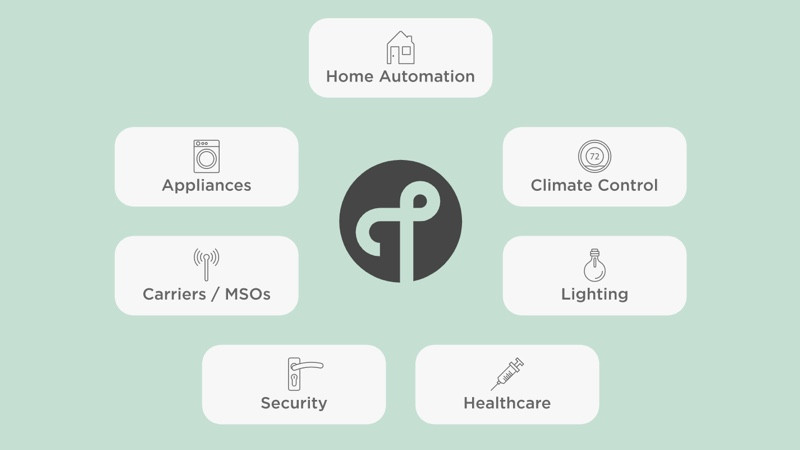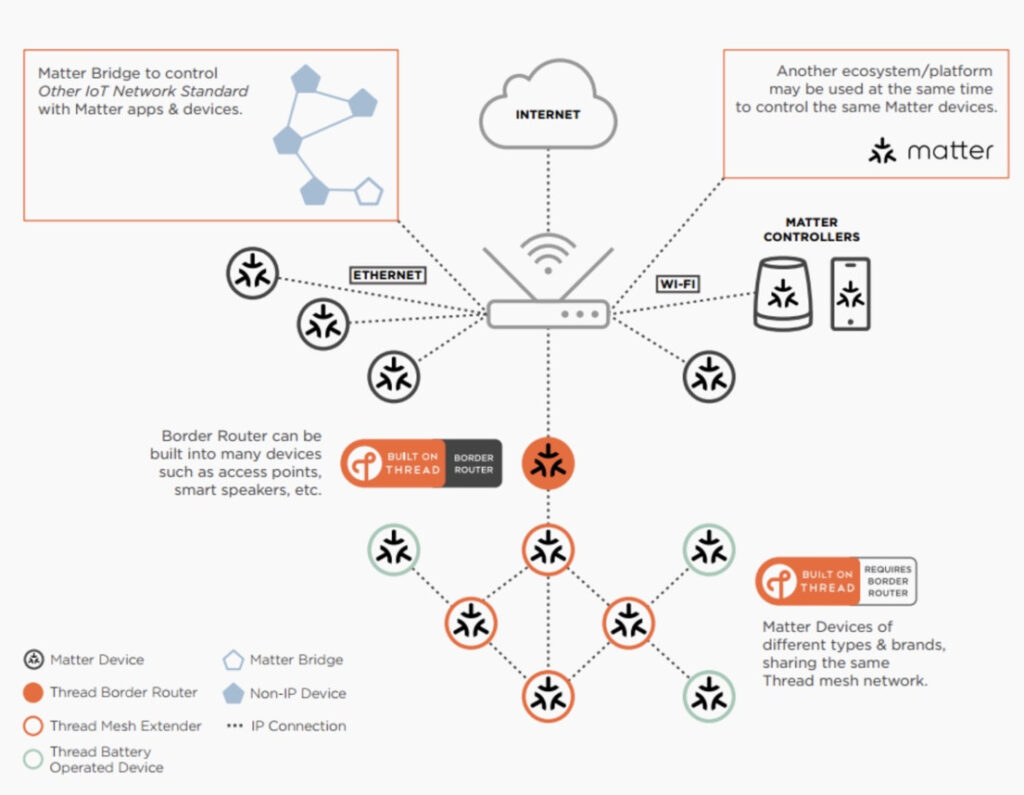
What the hell is Thread and why is it so important for the Matter smart home
Estimated reading time: 1 minute
Nobody really paid any attention to The Thread Group before Apple joined back in August 2018, even though the likes of Google and Amazon were already members.
The Thread Group is group of companies that support a mesh network protocol called Thread. And if no one paid attention to Thread Group, certainly no one paid attention to its protocol.
Instead, all of the attention had been focused on Zigbee and Z-Wave, the established standards of the smart home, and for good reason.
There are a number of smart devices out and about that support both, and major players like Samsung, Abode and Amazon even make hubs for them.
But Thread could yet be the single most important wireless protocol for the future of the smart home, especially as it’s at the forefront of the Matter smart home initiative which is picking up momentum. There are already a bunch of Matter smart home devices that use Thread.
So it’s a future that’s already begun – the likes of Apple, Amazon, Google and Nanoleaf already have Thread hubs – aka Thread border routers – on sale and possibly, even without you being aware, in your home.
But what exactly is Thread, how does it work, how does it tie-in with Matter, and how is it going to make your smart home better?
Here, we explain all.
What is Thread and how does it work?
Thread is a low-power mesh networking technology protocol designed to connect all the devices in your home, but that’s not what makes it interesting. What makes it interesting is that The Thread Group is pushing a standard that solves some smart home problems.
The Thread Group feels that it can be difficult to get devices to talk to each other, and that when they do talk, connections can be spotty and soak up battery life on mobile devices. Thread is therefore aimed at securely connecting devices without blowing through battery life.
Like Zigbee and Z-Wave, Thread can connect all your devices together in a giant mesh. Unlike Zigbee and Z-Wave, Thread doesn’t require a smart home hub to connect them; they just require a Thread border router.
A Thread border router connects a Thread devices to other IP-based networks, such as Wi-Fi or Ethernet.
And the good news is that Thread border routers are already widely available. You may already have one in your house without realizing it.
The Apple HomePod Mini contains a Thread border router, as does the latest-gen Apple TV 4K. Amazon has Thread border routers in the 4th-gen Echo, the latest Echo Show 8 and the Echo Hub.
Google has been building Thread radios into its devices for years and the likes of the Nest Hub Max smart display, 2nd-gen Nest Hub and the Google Nest Wifi mesh router all now act as border routers.
Nanoleaf also has Thread border routers built into some of its smart light systems and we’re bound to see more devices become routers in the future.
Thread devices connect to each other without a single point of failure, which also means the network can “self-heal.” So if one device goes down or a connection becomes spotty, the network can adjust and carry on without breaking.
Most importantly, Thread is interoperable by design. It uses open standards like IPv6 and a 6LoWPAN foundation. Translation: All your devices would be able to talk to each other, no matter the manufacturer.
Right now, when you’re trying to pool your smart home devices together into routines, you use services like HomeKit, IFTTT, Alexa and Google Assistant. They essentially act as remotes that make it seem like your devices are working together seamlessly. Like when you say good night and your door locks and your lights turn off.
Thread, on the other hand, would let your devices directly talk to each other. So your smart lights from Philips could talk to your from LG refrigerator without a hub or a service getting in the middle of it.


It also uses AES encryption, which Thread Group says closes holes that are present in other networking protocols. It’s worth noting that Zigbee and Z-Wave also use AES encryption, though Thread also uses banking-class, public-key cryptography to back it up.
As for how many devices you can use, a Thread network in your home can support over 250 devices with multiple hops. Then there’s energy use: Thread Group says Thread’s power efficiency means that devices running on AA batteries will last for years, as it runs on the power-efficient IEEE 802.15.4 MAC/PHY and uses short messaging between devices to conserve power.
The good news with Thread is that it’s a technology that can be enabled in some older devices using firmware; as long as devices support the 802.15.4 protocol then they can be upgraded to support Thread.


But what does that all mean for you?
Thread should mean that your smart home devices work faster, more securely and with less issues than ever before; especially compared to Bluetooth and Wi-Fi devices.
Take, for example, the Nanoleaf Essentials smart lights, which have Thread on board. These are HomeKit compatible smart lights that, in the time before the HomePod Mini, would have used Bluetooth to connect to a HomeKit Hub.
And that’s fine, sort of – but Bluetooth is notoriously laggy and so you don’t get an instant result following a voice command, press of a button in the Home app, or via a HomeKit automation.
And while the likes of Zigbee and Z-Wave are super fast, these aren’t protocols that Apple plays particularly nicely with.
And, the fact that Big Tech is enabling Thread is a big deal. Especially as Thread – alongside Wi-Fi and Bluetooth – is a pillar of Matter.
What is Matter?
Late in 2019, the big boys of tech teamed up with the Connectivity Standards Alliance, to create the Connected Home over IP Project; an initiative to “simplify development for manufacturers and increase compatibility for consumers” in the smart home world.
CHIP was based around a shared belief that smart home devices should be secure, reliable, and seamless to use.
The plan was to make it simpler for brands and manufacturers to build devices that are compatible with the likes Alexa, Siri, Google Assistant.
Thread is one of the main technologies running the Project CHIP show, which came to life as Matter in late 2022, with Matter-over-Thread being one of the key protocols of the new standard.
Explainer: What is Matter smart home
Many Matter controllers pack a Thread border inside and the good news is you probably won’t have to buy a new device as the likes of Amazon, Apple, SmartThings and Google – as mentioned above – all have Matter and Thread plans for a range of existing devices.


However, you need to be aware that, as it stands right now, Matter over Thread is anything but plain sailing.
That’s because, despite Thread’s biggest strength being the mesh capabilities it offers as detailed in the diagram above, the major players of the Matter smart home initiative have still yet to agree on the best way to implement this.
When it comes to Matter the likes of Google, Apple, Amazon and Samsung haven’t yet settled on a standardized way to share Thread credentials. Which makes things a little messy.
People are currently finding that, rather than one Thread network in their homes, all singing and dancing from the same hymn sheet, they end up with multiple Thread networks all living alongside each other – even if some of those Thread networks are Matter-enabled.


This issue, highlighted by the image above showing all the Thread networks in my house, isn’t a major problem; you won’t get network interference as you would if you had multiple Wi-Fi networks, for example – but it’s still not ideal and kind of negates the whole point of the power of the shared Thread mesh.
It’s a CSA Matter problem to solve though, not the Thread Group’s, although the latter is making things a bit easier.
Early in 2024, the Thread Group announced a series of improvements with Matter in mind.
The first major improvement coming Thread’s way is improvements with border routers that should solve the credential sharing issue.
The Thread Group’s strategy involves standardizing how border routers share credentials across different manufacturers, ensuring a unified Thread mesh network.
This solution aims to reduce latency, eliminate points of failure, and even enhance battery life of Thread devices.
Who is The Thread Group?
The Thread Group is, well, a group of companies with an interest in developing and supporting Thread. Its board consists of executives from the likes of Apple, Google, Yale, Qualcomm, Lutron, Somfy and Siemens.
The Thread Group isn’t exactly a standards body. Instead, it considers itself a group focused on educating the market and developers on the benefits of Thread, hoping to expand its reach. It also does certifications on Thread technologies and products.
Thread Group’s membership list reads as a who’s who of the smart home world. There’s Apple, Google and Amazon, which is important as they’re the big three of smart homes. But just as important, there’s the likes of D-Link, Eero, Kwikset, LG, Lutron, Bosch, Samsung, Signify, Tado, LG, Somfy, Tado and Yale.


Are there any Thread devices?
Yes indeed, lots. As mentioned, the HomePod Mini was the first hub to open up its Thread radio and the likes of Nanoleaf and Eve started offering HomeKit devices that are Thread compatible back in 2022.
Since then, we’ve seen a barrage of Thread enabled devices announced, a lot of which are also Matter-over-Thread devices.
Here’s the thing: Thread can be added to nearly any device with a simple software update. As long as these devices support the 802.15.4 protocol then they can be upgraded to support Thread. That’s the route Eve has taken with its first wave of Thread-compatible devices.
Google Nest already used a combination of Thread, Wi-Fi, and Bluetooth to get its devices to talk to each other. It’s been doing this since way back in 2016. You can thus see all the potential benefits of Thread in the Nest Guard, Protect and Detect devices.
Google has also put a Thread radio in some of its smart home devices such as the Google Nest WiFi system and the Nest Hub Max and, as mentioned, Thread 1.3.0 means that these can act as border routers for non-Google/Nest devices too.
In terms of devices around your home we’ve already seen smart locks, smart plugs, smart sensors, smart blinds and heating devices from the likes of Eve, Schlage, Aqara, Wemo and Siemans go live with Thread on board and some of these devices are now Matter certified as well.
It’s clear we’re looking at a smart home future where Thread is a major player.






